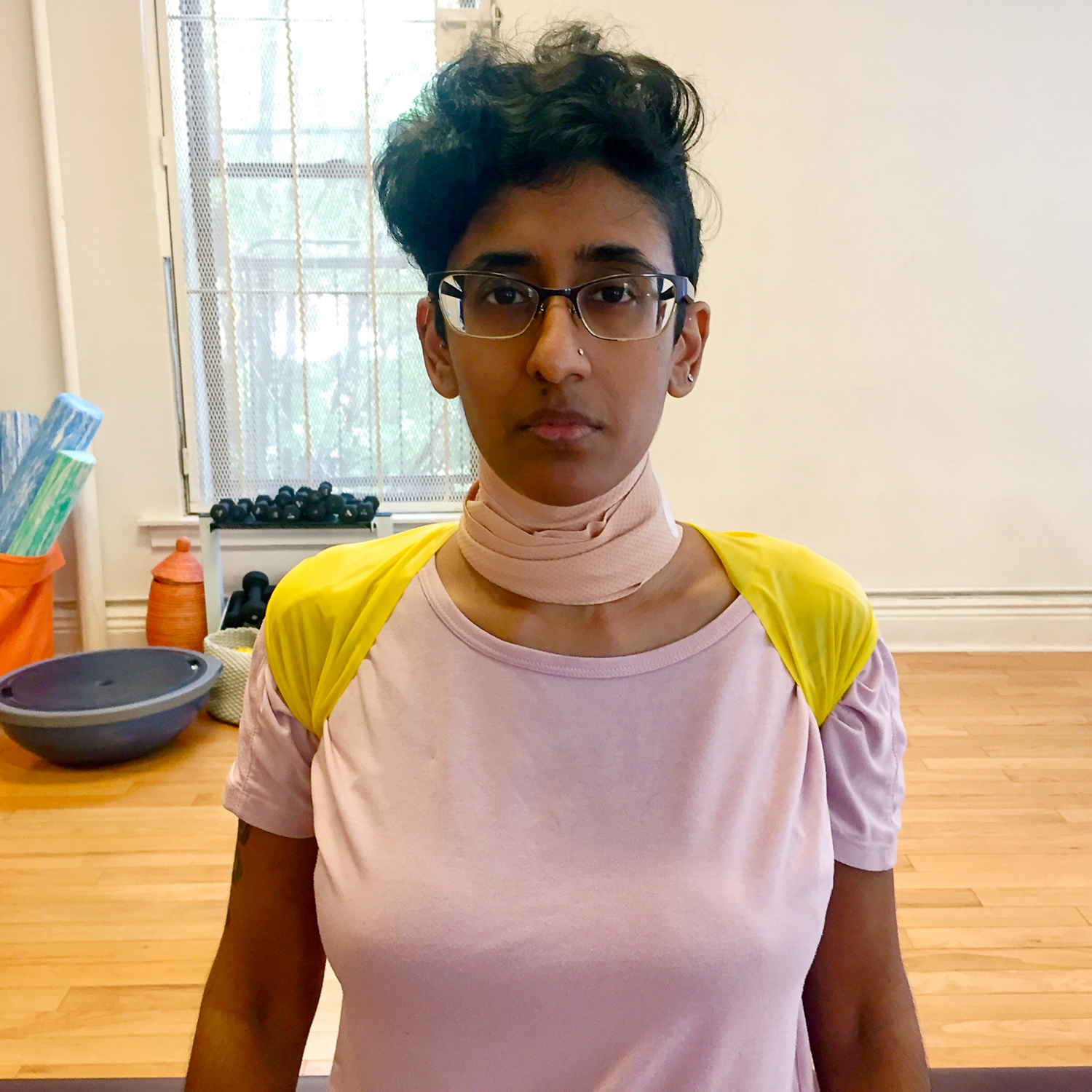87. Around Pain
Vy asked me to write something up — a collection of memories surrounding her, us, pain, medicine, diagnoses, surgeries, systemically pervasive and dyadic medical, academic, and societal prejudices affecting said subjects. When I met Vy, I was finishing my M.F.A. in photography at the School of Visual Arts at age 25. She was 23. My pain at that time was starting to spread from isolated joint/muscle injuries to a more pervasive whole-body picture, that would eventually be labeled Fibromyalgia with body dysregulation (especially temperature). Many pointed towards my psychology when they couldn't find answers. Steroids and Pilates help me. The first rheumatologist I visited in 2008 suggested Fibromyalgia, quietly shut the door and started talking about a pain management clinic focused on medication and said, "Push hard enough anywhere and it will hurt." Now, 15 years later, I am a Pilates instructor and have used my pain to inform my teaching and guide my desire to help others. But I am not a healer and whatever helping I achieve with the bodies I work with feels vastly out of my reach, lost in the undefinable, uncontrollable thing we can't understand or fully know even when it stares us straight in the face or in the gut — pain and the body. Bodies are mapped in pain. I see amazing perseverance, over and over again, to traverse that trail.
I have two first memories of Vy. One, smiling at the entrance to Mary's and my old railroad apartment in the Theater District where we lived until 2006. Two, the only person at a Columbia M.F.A. writing party that I felt I could genuinely talk to.
Pretty quickly a couple of threads of our existence/friendship come to mind: food/work/art/writing and pain/health/massage/Pilates.
Dinners at our apartment, weekends of food and massage: Sometimes both Mary and I massaged Vy at the same time, trying to release tension and tightness in her trigger points and lines and spaces in between. I tried to make myself a great chef and armchair nutritionist, hoping that the meals I was making helped . . . or at least brought happiness. Eating would become hard for Vy due to pain, which has increased since her appendectomy.
I remember bearing witness in 2009 to the ethnic conflict in Sri Lanka and the genocide of Sri Lankan Tamils with Vy perched on our couch refreshing news stories or emailing back and forth what we could find published. I remember reading Vy's M.F.A. thesis, a novel titled Through a Glass Darkly, in 2008, and her in-progress memoir Black Tiger White Van in 2009, and becoming a fan and championing her work. This led to years of collaborations between photos, drawings, and poems. Weekend plans, work parties, meeting her sister, Anji, more eating plans, music video parties, watching The Dark Knight Trilogy, hours of practice and planning out karaoking.
When the fantasy dies, we grow up or old, we grow gone. (S. Fuller, 2011)
But. I would willingly vanish if it meant I could take it back. It's as real as the ink on my hands. I can't play it in reverse, the blood receding back into his body, wounds closing, even fantasy doesn't work that way. When the fantasy dies, it's going to be my hands he's eating out of, whoever he is, wherever she is, whoever I'm supposed to be. (V. Manivannan, 2011)
I have been aware of Vy's pain since knowing her, and by 2007 she was diagnosed with Fibromyalgia. I began to try to help. The key word here is try, because at times it feels hopeless to try to help one through pain — Vy, Mary, myself, other clients. I tried to access my experiences to have the right thing to say, to correctly support a thing that we can't contain, define, understand, or control. To this day I don't know how to answer how I am doing, what to divulge? Positivity is not a possible state of being — I'm fine, I'm dead, I hurt, I can't, how how howhowhowhowhow
Anji moved to NYC in 2011, adding to our work/body/creative parties, which always helps with laughter and release. In addition to meeting at our apartments in Crown Heights and Harlem, we started finding midway rendezvous spots at restaurants and Mary's office in NoHo. This photo is from 2018 capturing one of many hangouts over the past decade 14+ years.
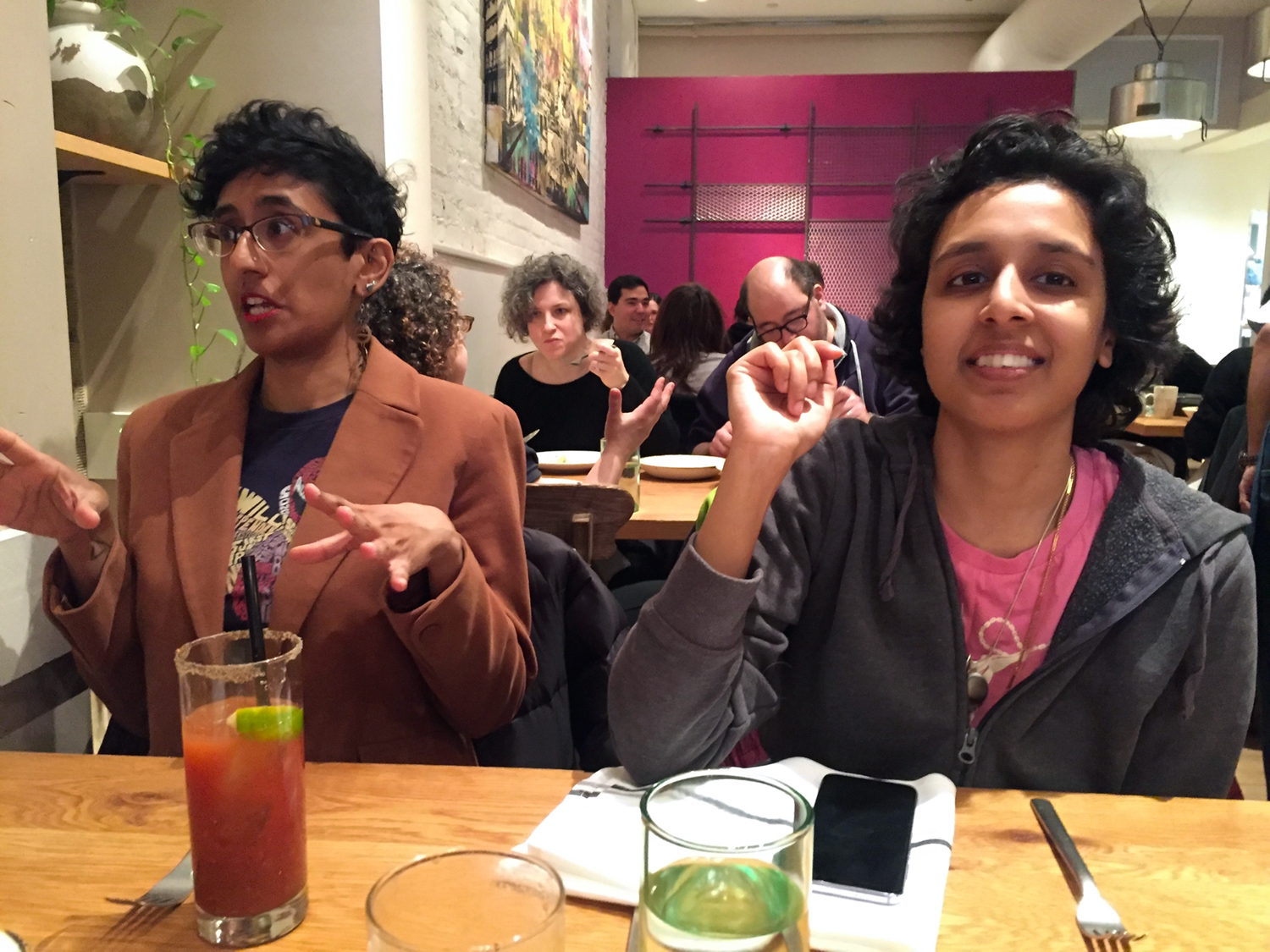
And the occasional outing; here, we went apple picking in 2013 (pictured below). It is important to note the amount we attempt to insert the norm, a bit of levity, throughout our friendship. (If only I had a video of us singing karaoke, you would understand so much more.) We have a group chat where we constantly check in with each other called The Zoobles, named after the 1980s children's television series Zoobilee Zoo, where humans dressed as animals worked and played together in the face of various community/neighborhood conflicts. Our togetherness is the only glue we have since everything inside the body is so tenuous and questionable.
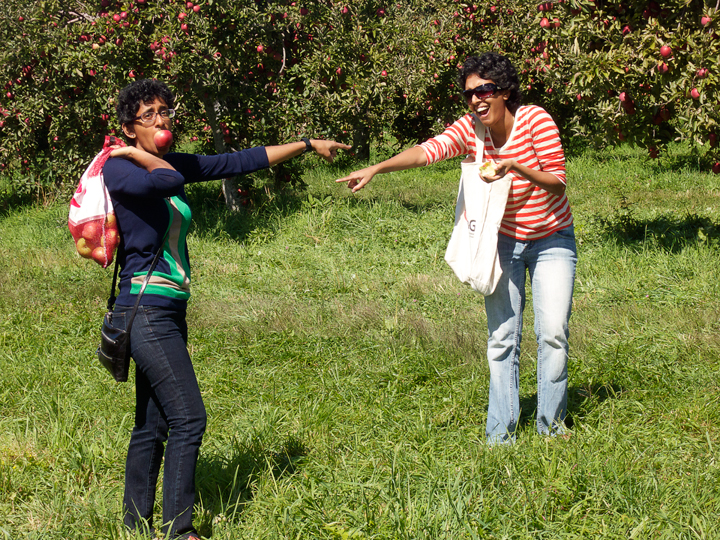
Eventually Vy and I began to work together in the Pilates studio. I wrote to Vy in 2012:
I am so sorry to hear about your pain and that brings me to. . . . Mary said you were curious about getting a massage. I cannot apply the same amount of pressure as what you are used to. However, I can apply some release techniques to the Plates work . . . the stereotype of Pilates is not what I am doing. Just like yoga, there are a lot of different approaches. In general, the reason why I am doing this is that it has helped me manage my pain. Not a cure all, but it is something. The catch about it is that it is something that has to be a constant or it doesn't work. For me and you, whether comparable or not, that means the work is like a medicine you can never quit.
From Vy: "Sara, if you still have time and the offer still stands, we should talk logistics about Pilates. Dr. Birnbaum was very positive about this, and even said you could call her to get a better sense of what's (most) wrong with me right now." And again from Vy, "I'm a broken human being so I imagine it would largely be massage and some gentle stuff."
Life carried on with the ebb and flow of pain to intolerable pain — "I'm fine" to "I can't." Work needing to be done, feelings of impossibility and hopelessness. Vy kept seeing me. Her psoas was chronically shortened, often spasming. Paraspinal muscles felt like taut wires. A back and spine left in deep pain. All the traditional tender points were troublesome, buried in layers of spasm, hardened with time. Knee pain, foot pain, hip pain, legs pulled in painful organizations between the joints. Chest pain, shoulder pain, collarbone displaced, neck pain, wrist pain, hand pain, arms pulled in painful organizations between the joints. Simultaneous skull pain, muscles bound atop the skull, causing pins and needles in the cheeks. Painful periods. But that only tells part of the story. The whole myofascial web — frozen. This endless connection, invisible to the outside eye, holding Vy captive, where she seems to acutely feel stymied in all directions. My goal was to make her tissues more sea anemone-like. In my early career, I wonder if I thought I could. Now I know I can only help the pain be as minimal as it will be. I can only help the tissue be as moveable as it's going to be. However, a little movement in a less painful direction can go a long way, or even a short way is helpful. So the little bit that we achieved through weekly diligence, I hoped made things like walking and stairs (one step/climb/descent at a time) something that could be done a bit more easily.
There are some clinicians who research pain in all its enigmas and treat Fibromyalgia. But the more common experience is that doctors still believe if they can't clearly test for something or visually see something, the issues are malingered or solely psychological. All physical pain and injuries have a psychological component and vice versa. That is not the question — why mistreat and mistrust the patient? The individual, genuinely explaining and presenting their experience, so often can't truly be seen if their symptoms don't follow a common pattern or if the patient doesn't look a certain way or hold a certain power (i.e., white, upper-class, male, able to assert their issues and be heard). Vy had a life-threatening experience with the perforation of her appendix. I witnessed varying degrees of doctor dismissals in the months/weeks leading up to it — when she was searching for help for her pain — for example, prescribing gastrointestinal medicines.
In a Google Chat from 9/17/2014, the day before she went to the ER, she relayed her interaction with her PCP Dr. Jiang, "'If this has really been going on for 3 weeks, I'd expect something really bad to have happened.' I know she was in a hurry, and she didn't dismiss my symptoms and talked about how ruptures can heal themselves, the body can build walls and surgery isn't even needed sometimes." From me, "I completely understand not trusting people. Even good people can at times be assholes . . . I value your will to show it, to heal, I think it might mean that even though you are at the end of your rope that you are still fighting and that you will pull through . . ."
It can feel uncomfortable to reveal one's pain to doctors when it is not a "simple" or "clear" pain. People in pain learn to conceal their pain to "fit in," to not be a complainer, to be viewed as "normal," so when one peels back those layers to show pain to any doctor, it can feel like a performance, from what clothes you wear to your facial expressions. This masking and disclosing are a result of the distrust and apathy from the medical world (as well academic and corporate worlds) and, by extension, the world in general, and it seems to make any kindness, especially for Vy, an overwhelming experience to respond to. Kindness from me, from Mary, from supervisors, from teachers, from students, can emotionally overwhelm her due to the great amount of doubt and blame society puts on people who are ill.
An email from Vy 9/17/14:
I had a noticeable cyst before so maybe? And I'm wondering if that weird pumping feeling has been either leaking or attempts at absorbing the blood? The pain might have been rupture, or maybe some cyst has just gotten so out of control it's pressing on my GI business. As for eating, it's less that I have GI problems than like something is in the way somewhere, so I just can't put a whole lot in. This shit is supposed to resolve itself though, I think? Either that or it turns into an infection if left alone too long. I forget. I thought about going to the ER again today but then I thought, but I waited this long, why break now. . . .
On 9/18/14, Anji emailed us letting us know Vy went to the ER. An email later that day from Vy, "As far as I know an iv will be involved, possibly antibiotics and more tests and imaging." A response from me that sums up my feeling over the past months, "worried worried worried." More response from Vy, "Terrible inflammation on the right side, could be ruptured ovary, malignant ovary, or appendix perforation...HAHAHA THEY THINK SOMETHING'S PERFORATED AND THAT'S CAUSING THE INFLAMMATION." From Anji on the 18th, "Can't sleep now because worried!!!!!" Again from Anji, on 9/19/14, 4:09 AM, "Bonus points to Mary and/or Sara if you manage to sneak into the hospital a la Batman visiting Gordon [in The Dark Knight Rises]." On Sep 19, 2014, at 5:59 AM, Vy wrote, "Haven't even gotten the second course of antibiotics. Some kind of surgery to be happening this morning if anyone ever gets to me. I'm tempted to just leave."
Finally a doctor took it seriously, though the slow perforation resulted in severe inflammation in her abdominal and pelvic region with surrounding tissues adhering to the perforation. It's unclear how much longer she could have waited, but damage had already been done. We hoped professionals would have caught it — could they have, why didn't they? Suggesting she go back to the doctor, which we did (and despite our frustrations with the medical industry, we still do), then (and now), felt (and feels) like resigning ourselves to more inefficacy and potential emotional trauma. How does one know if anything is bad enough to go to the ER on their own accord when many days/nights are spent in terrible, death-fearing pain?
Vy, 9/25/14, "there WAS a rupture into the abdominal cavity AND into the tissues of the involved organs. My PCP now thinks the appendix was the source and just infected everything around it because it was ADHERING TO ITS SURROUNDINGS."
This situation has led to more complications. She had another series of bad abdominal issues in 2016 — doctors considered Gastroparesis. The pain and complications continue to this day.
There is always a component of the spasming psoas. Whether the cause of the pain or the result of the trauma, the psoas reacts. Post-traumatic stress results from this whole life experience of pain and health trouble, but, also, specifically the experience that led up to her appendectomy and the stay in the ER — constant probing, no sensitivity to pain or emotion from doctors and technicians, feeling dismissed and looked passed, feeling distrusted and un-listened to, constantly having to prove herself. Later when her Appa was in the hospital, she would draw a connection to how he, with a doctorate in physics, a tenured professor, would have to have his status announced at doctors to get taken seriously, just as she would announce her Ivy League degrees.
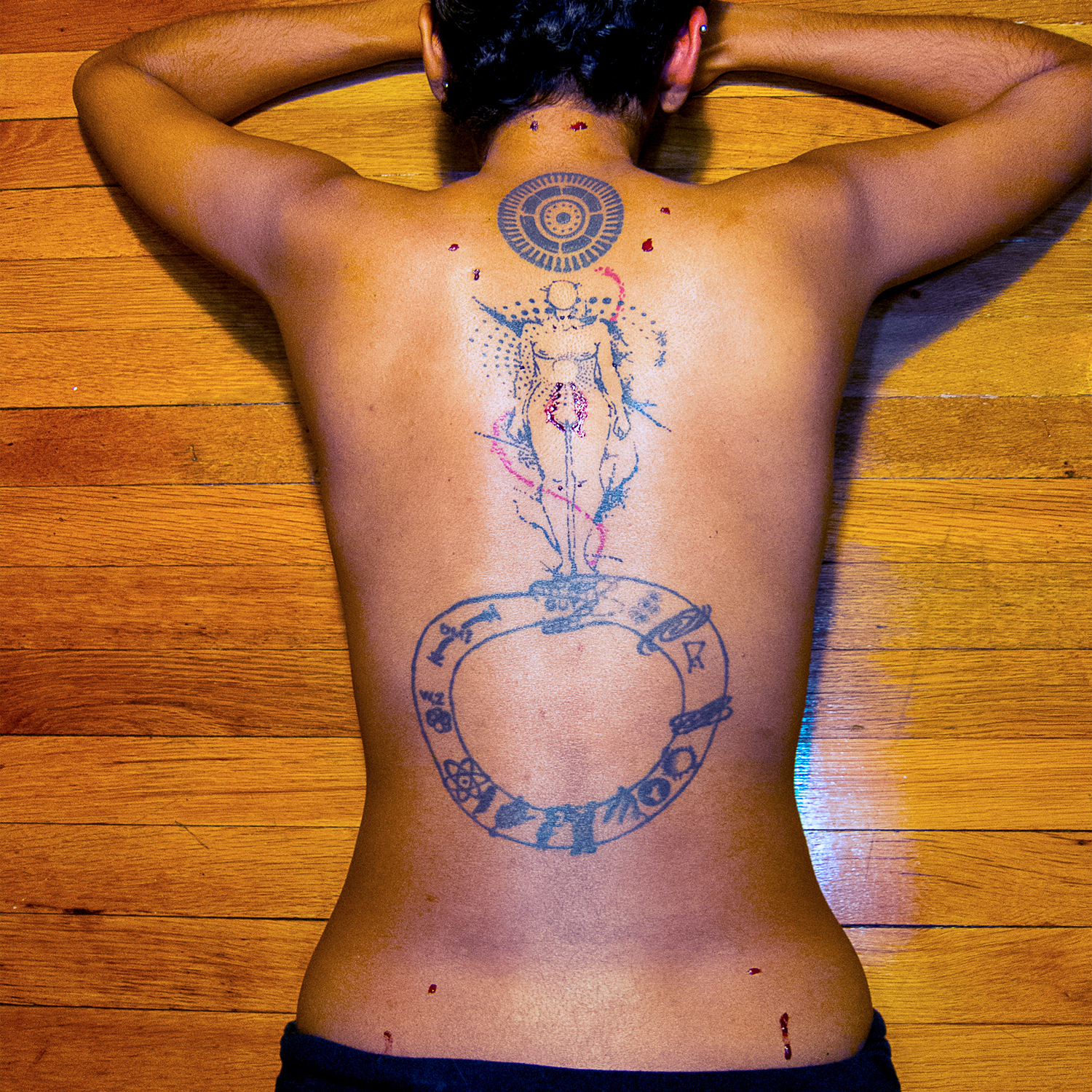
All of this happened and continues to happen every time the abdominal region seizes. The psoas will stay on alert with your emotions. The psoas will contract, will spasm as if the traumatic event is happening all over again. It will respond to the conflating of time and it will create pain, and it will further scramble perception, emotions, and health. In this photo (left) we attempt to show this by painting fresh blood on the psoas of the figure tattooed on her back and dotting blood on various trigger points.
Because the psoas is so deep, attaching at the lesser trochanter, running along the iliacas, interdigitating with the front of each lumbar vertebrae, ending at the diaphragm, it is extremely difficult to palpate — massage of this area is often getting at more superficial tissues and muscles. Therefore we often tried to help her psoas relax in a constructive rest position (pictured below). Sometimes I would work on her neck or skull muscles at the same time. The goal of this position is to put the psoas in a shortened position where it is not working, in the anti-gravity orientation with supports holding up the legs in 90-degree hip flexion and 90-degree knee flexion. Using a rope to hold the legs together, and sometimes the arms, helps the muscles fully relax. After 5 minutes, the instinctual flight or fight reflex, the chronic shortened overworking, sometimes, can start to unwind.
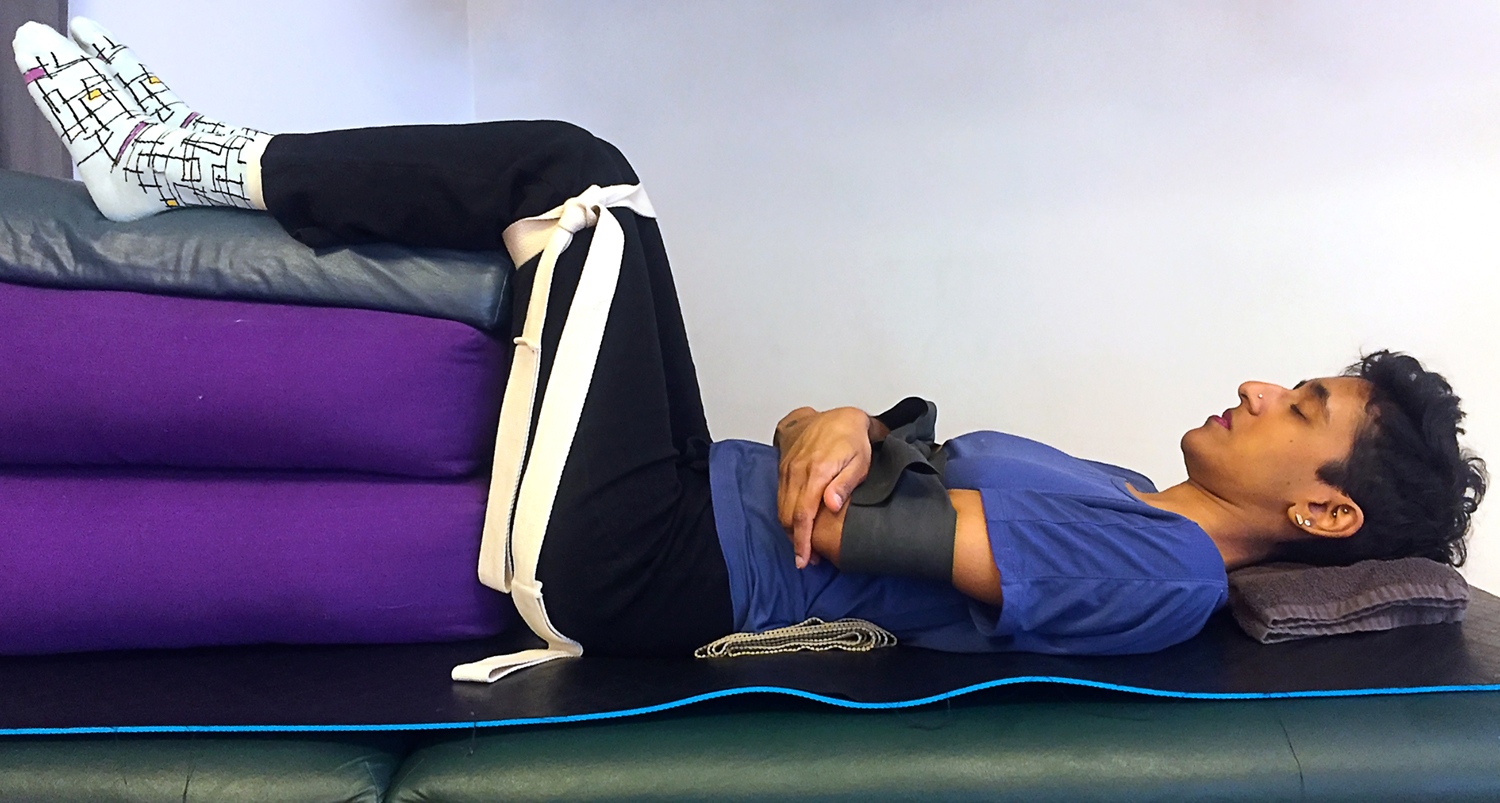
In 2020 a doctor diagnosed Vy with Myalgic Encephalomyelitis/Chronic Fatigue Syndrome and Immunodeficiency and started to look for root causes. However, sadly, this doctor would turn out to be unhelpful as soon as Vy was unable to pay a high follow-up fee just for a prescription to recheck blood work — as if the doctor held no responsibility after placing all these verdicts in Vy's lap.
Vy wrote on 2/16/15, "I feel so alienated from everything — my gchat people aren't around when I am and I can't even talk to them on the phone or anything! Also all this coughing is starting to hurt in the post-op places . . . 😕" This is from a night when pain wouldn't let Vy sleep. Though we are there for each other, pain is a solitary experience and can leave us feeling very alone. A loneliness created in part by life, the human condition, but also from the pain, pain that makes one's own body feel like an enemy holding us away from our hopes and dreams or simply a sense of ease, even if momentary. In between all of these moments of pain and complication, we find togetherness and connection, a shared understanding of the world. We talk about troubles, we glimpse joy and the brilliance of one another, and we try to find a way to wade through.
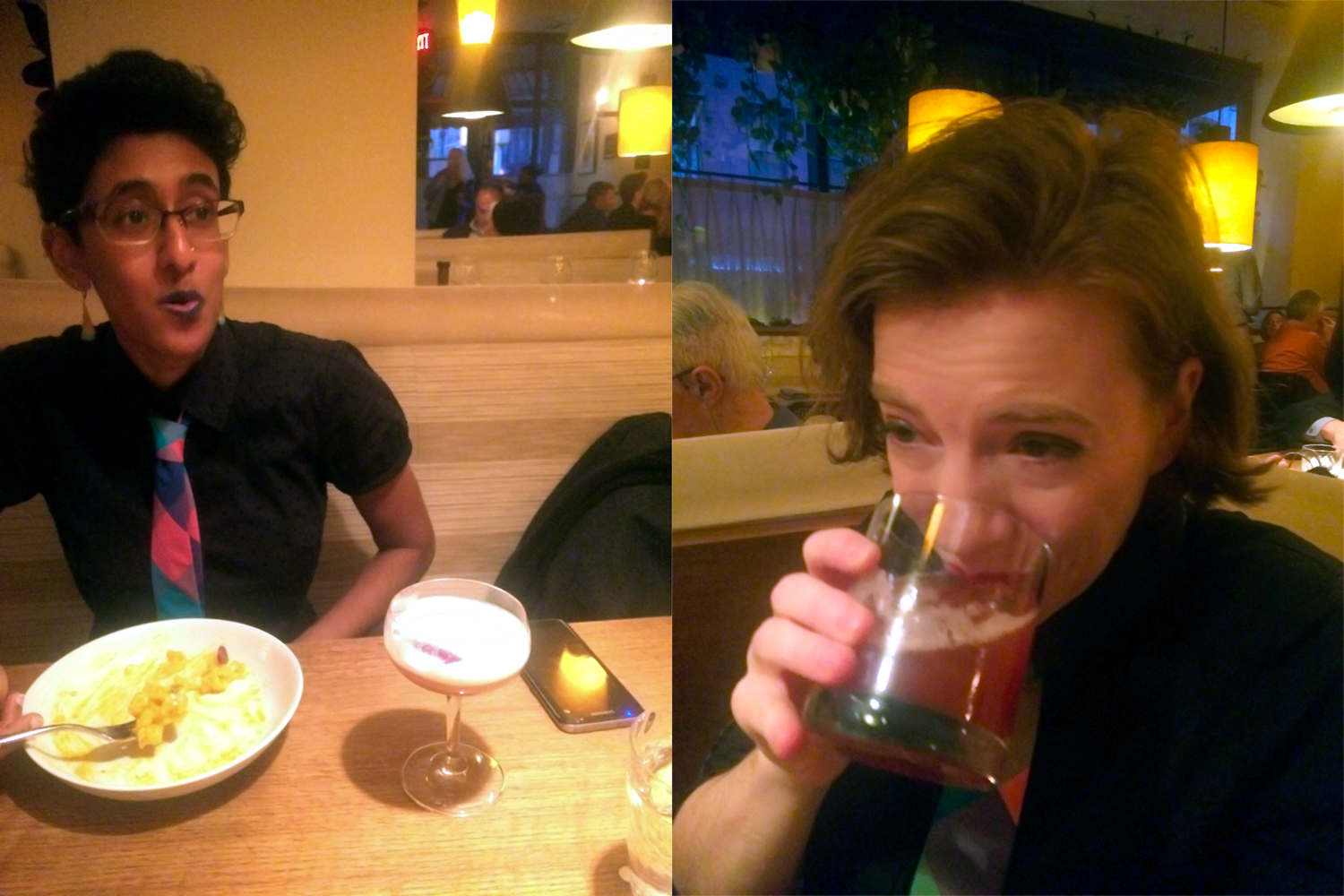
Quick snippets, a small sampling of Vy's comments via Google Chat regarding pain:
- 7/30/2013: in constant fatigue and pain
- 10/21/13: The pain feels like its inside the hip joint if that makes any sense — it's very sharp and sudden when I put my weight more towards the outside of the foot.
- 1/15/2014: There's something so terribly wrong in my right collarbone/shoulder that I went back to taking the prednisone (just 1x daily) as of yesterday
- 2/10/2014: So, we're on for 2:30, right? Just double-checking. My back and knees are MURDERRRRRRRR
- 3/11/2014: I spent yesterday more or less curled in a ball profusely sweating and having chills due to abdominal pain (centered and left). It set in immediately after I ate, so I only ate twice. I considered the ER but decided to wait it out and see.
- 5/9/2014: I hurt so bad, Collarbone hurts into my throat, Neck/shoulder area
- 5/12/14: Chest wall pains all last night
- 10/8/15: Was just wondering if you had time for a quick Pilates session this weekend? I'm free tomorrow and all weekend... mainly worried about my low back/abdomen as I feel the pain starting up 😕
- 3/28/16: I feel terrible these days and don't know what to do 😕
- 3/29/17: I just want to say, I hurt so bad I could barely get home
- 9/27/2017: Pain is destroying my sleep, and so is my period attempting to begin. Already canceled my classes tomorrow ugh.
- 3/15/18: my uterus is savaging me
- 7/31/2020: woke up and my whole shoulder girdle was fucked
A few weeks ago, I was walking down the street and a child looked back at me from their stroller, smiling with wide eyes and a half-smile, as if just coming into awareness of others outside themself. I was experiencing stomach pain that day and had a sharp stabbing pain and hunched forward with my hand on my abdomen. The child continued to look over the side of the stroller, watching me double over. The child's smile turned to a look of concern, their eyes moving to my hand clutching my stomach. While dozens of adults buzzed past me, this child, barely verbal, was the only person who recognized something was wrong. I began to wonder if this child is also plagued with stomach aches and noticed something recognizable in my posture. Or if the child had no such experience at all, but was merely responding to what they could see, right in front of them. This small semi-imagined moment of recognition on the sidewalk offered me more hope than any of my own medical experiences. I imagined this child growing up and becoming a doctor who can look at pain and not look away. I try to hold on to this moment, to the idea that a new generation of doctors will not turn away from chronic pain and illness, from the difficult to diagnose, and begin to look and listen to what the patients have been trying to tell them all along. We are in pain. We are hurting. You may not have an answer, you may not have cure, but to deny our experience and our existence is to add yet another layer of pain and indignity — and puts us at serious risk.
